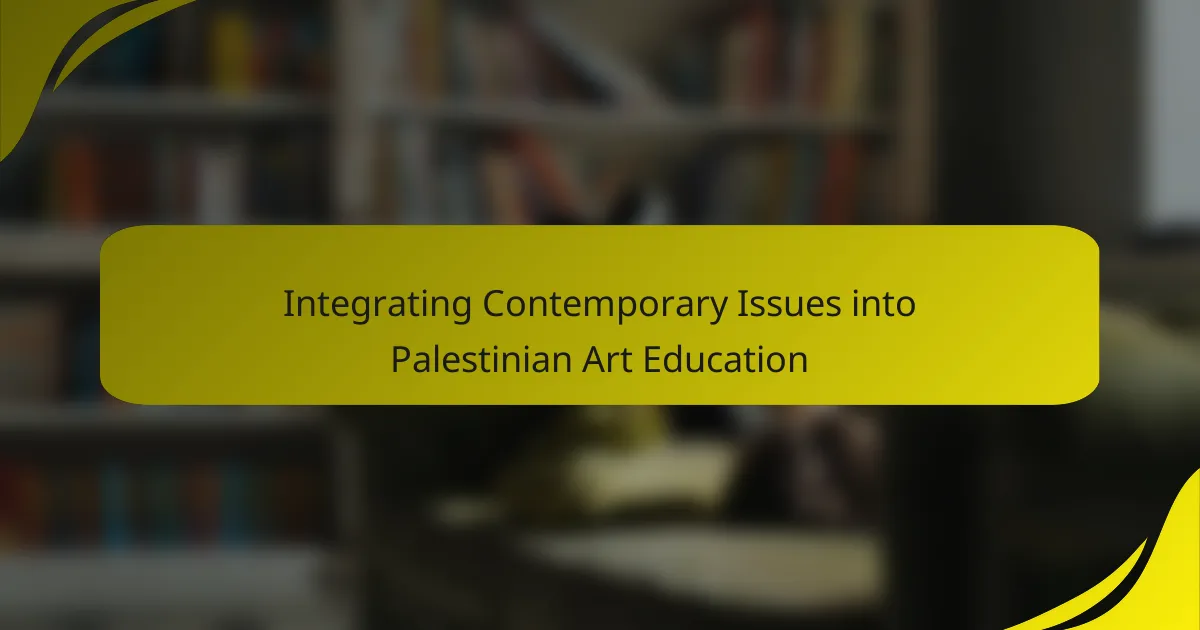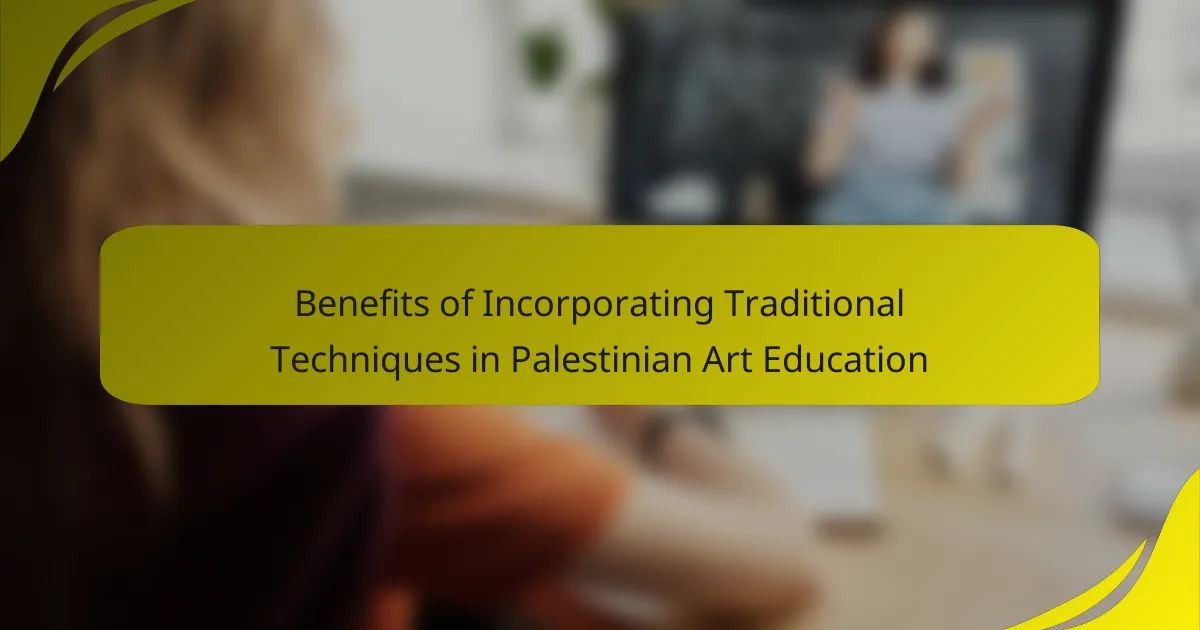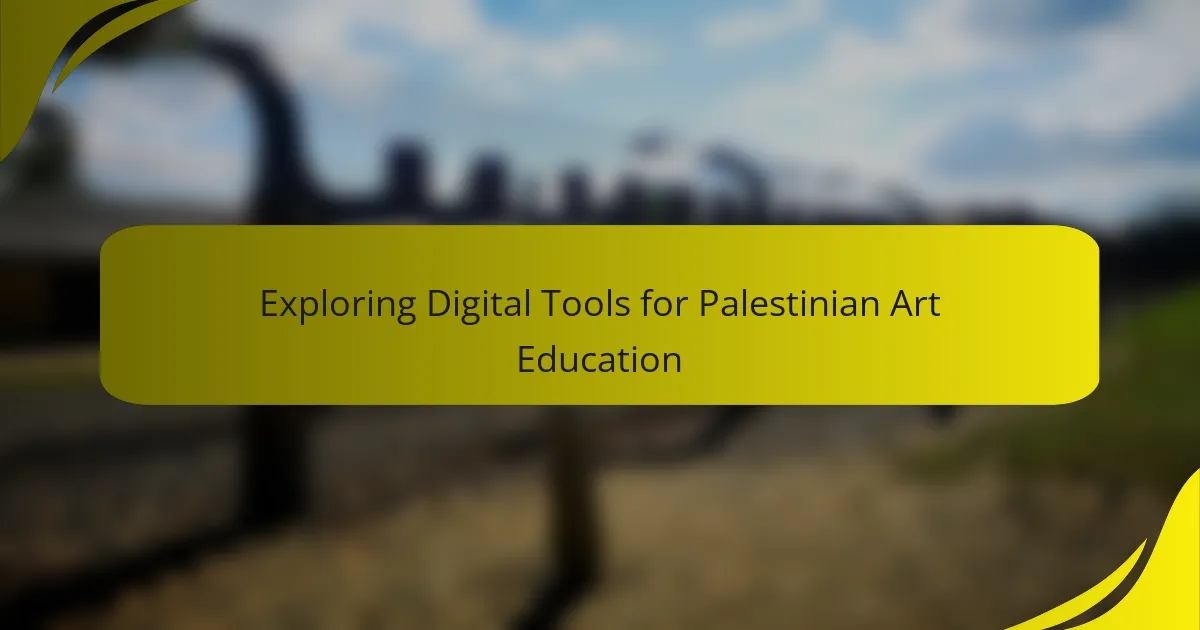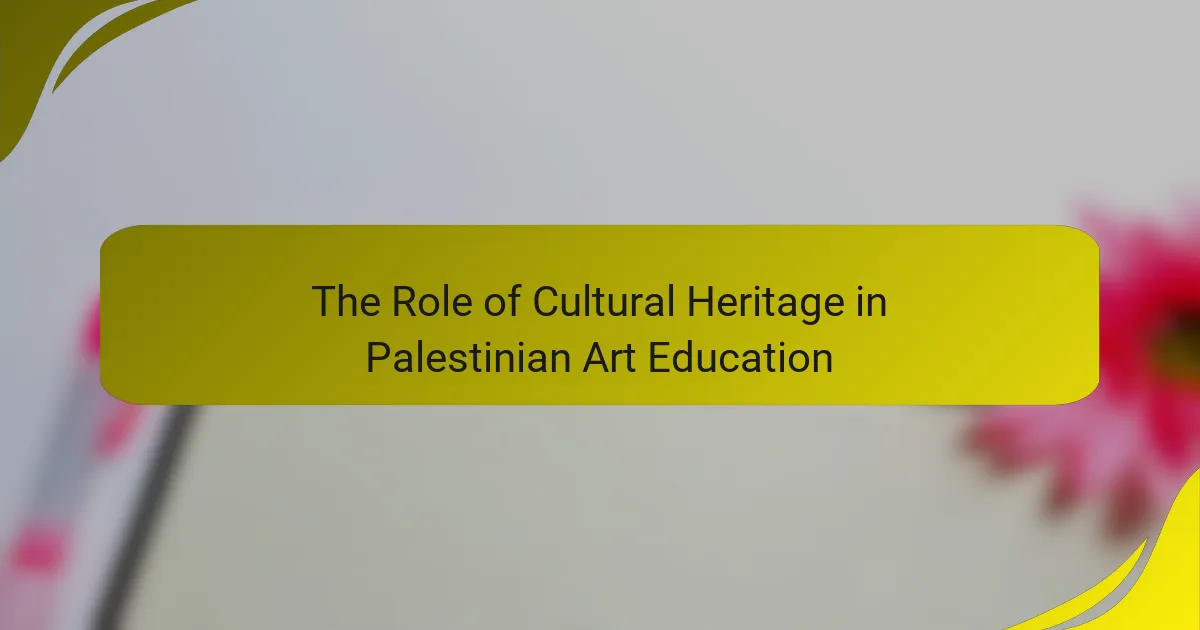Teaching strategies for diverse learners in Palestinian art education focus on differentiated instruction, culturally relevant pedagogy, and collaborative learning. Differentiated instruction customizes teaching methods to accommodate individual student needs, enhancing engagement and achievement. Culturally relevant pedagogy connects educational content to students’ cultural backgrounds, fostering relevance and connection. Collaborative learning promotes teamwork and peer support, allowing students to learn from each other’s perspectives. Research supports the effectiveness of these strategies in improving learning outcomes in multicultural classrooms, highlighting their importance in creating an inclusive educational environment.
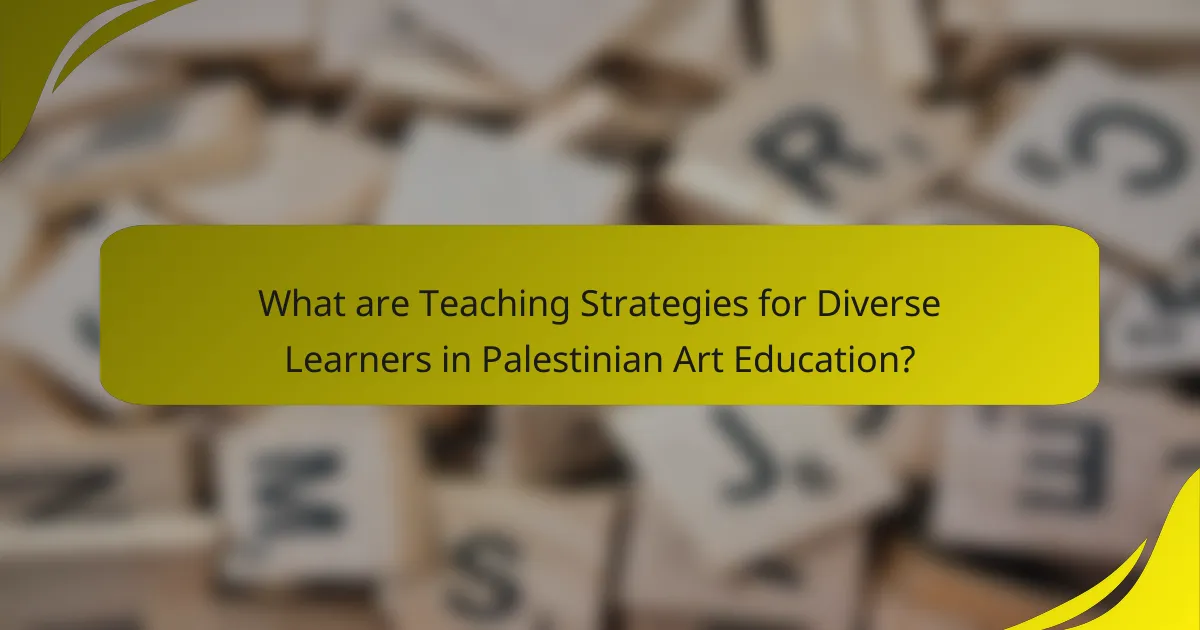
What are Teaching Strategies for Diverse Learners in Palestinian Art Education?
Teaching strategies for diverse learners in Palestinian art education include differentiated instruction, culturally relevant pedagogy, and collaborative learning. Differentiated instruction tailors teaching methods to meet varied learning needs. This approach allows educators to adapt lessons based on students’ abilities and interests. Culturally relevant pedagogy integrates students’ cultural backgrounds into the curriculum. This method fosters engagement and connection to the material. Collaborative learning encourages teamwork and peer support. It helps students learn from each other’s perspectives. These strategies enhance inclusivity and promote a richer educational experience. Research indicates that such approaches improve engagement and learning outcomes in diverse classrooms.
How do teaching strategies accommodate diverse learners in art education?
Teaching strategies accommodate diverse learners in art education by employing varied instructional methods. These methods include differentiated instruction, which tailors lessons to meet individual needs. Visual aids enhance understanding for students with different learning styles. Collaborative projects foster peer interaction and support. Flexible assessment options allow students to demonstrate their learning creatively. Culturally relevant content connects art to students’ backgrounds. Providing multiple forms of media ensures accessibility for all learners. Research shows that these strategies improve engagement and learning outcomes among diverse student populations.
What specific needs do diverse learners have in Palestinian art education?
Diverse learners in Palestinian art education require tailored instructional strategies. They need access to resources that reflect their cultural backgrounds. Differentiated teaching methods accommodate various learning styles. Support for emotional and social development is crucial for engagement. Opportunities for collaborative projects foster peer interaction. Accessibility to materials and tools is essential for all learners. Training for educators on inclusivity enhances teaching effectiveness. Lastly, community involvement enriches the learning experience.
How can cultural context influence teaching strategies for diverse learners?
Cultural context significantly influences teaching strategies for diverse learners. It shapes how students perceive learning and engage with content. Different cultural backgrounds bring unique perspectives and experiences to the classroom. These differences can affect communication styles, learning preferences, and values regarding education. For instance, collectivist cultures may prioritize group work and collaboration. In contrast, individualistic cultures might emphasize personal achievement and self-expression.
Educators must recognize these cultural influences to adapt their teaching methods effectively. Strategies such as incorporating culturally relevant materials can enhance engagement. Additionally, understanding cultural norms helps in creating a supportive learning environment. Research indicates that culturally responsive teaching improves academic outcomes for diverse learners. According to the National Education Association, students perform better when their cultural backgrounds are acknowledged in the curriculum.
Why is it important to implement diverse teaching strategies in art education?
Implementing diverse teaching strategies in art education is crucial for fostering inclusivity and creativity. Diverse strategies address varied learning styles and cultural backgrounds. They enhance student engagement by making lessons relevant to all learners. Research shows that students perform better when their unique perspectives are valued. For instance, a study by Tomlinson (2014) indicates that differentiated instruction leads to higher academic success. Diverse teaching methods also promote critical thinking and problem-solving skills. They encourage collaboration among students, enriching the learning environment. Overall, these strategies prepare students for a multicultural society.
What are the potential outcomes of using diverse teaching strategies?
Using diverse teaching strategies can enhance student engagement and improve learning outcomes. These strategies cater to varied learning styles and needs. Students often demonstrate higher motivation when lessons are tailored to their preferences. Research shows that differentiated instruction can lead to better academic performance. A study by Tomlinson (2001) indicates that students in differentiated classrooms exhibit increased achievement. Furthermore, diverse strategies promote critical thinking and creativity. They encourage collaboration among students with different perspectives. This fosters a richer classroom environment. Overall, implementing diverse teaching strategies supports inclusive education and benefits all learners.
How do diverse teaching strategies promote inclusivity in art education?
Diverse teaching strategies promote inclusivity in art education by addressing varied learning styles and cultural backgrounds. These strategies include differentiated instruction, which tailors lessons to meet individual student needs. They also incorporate collaborative projects that encourage peer interaction and understanding. Visual aids and hands-on activities enhance engagement for all learners. Culturally relevant materials reflect students’ experiences and foster a sense of belonging. Research shows that inclusive teaching practices improve student participation and creativity. A study by Tomlinson (2014) indicates that differentiated strategies lead to better academic outcomes in diverse classrooms. Thus, diverse teaching strategies are essential for fostering an inclusive art education environment.
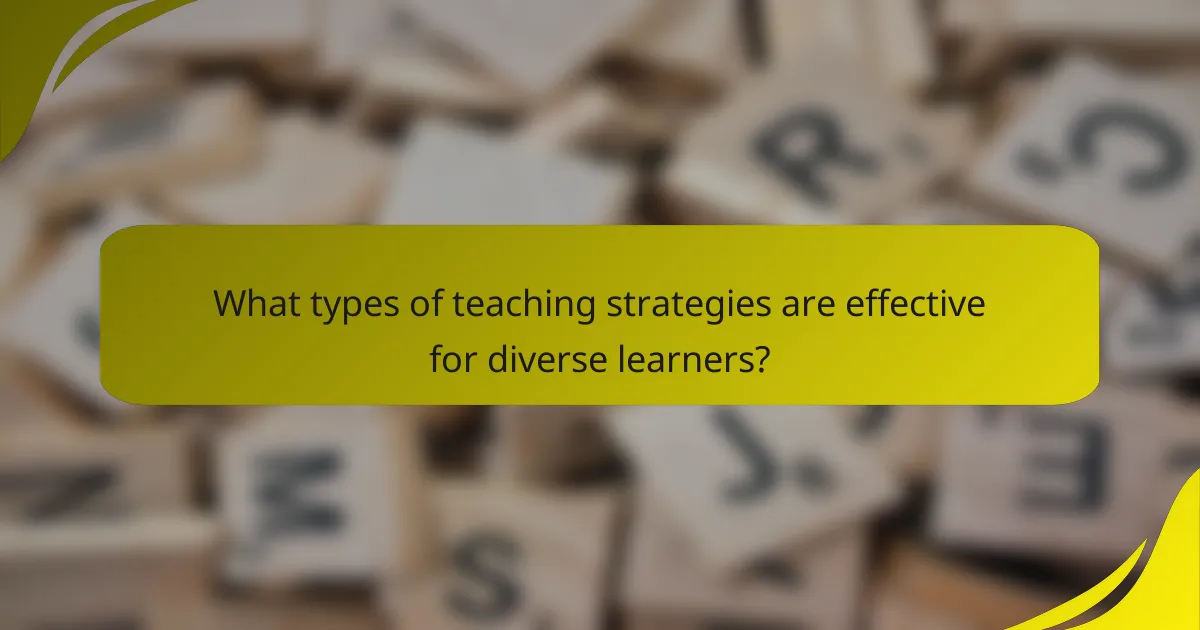
What types of teaching strategies are effective for diverse learners?
Effective teaching strategies for diverse learners include differentiated instruction, culturally responsive teaching, and collaborative learning. Differentiated instruction tailors lessons to meet the varying needs of students. This approach can involve varying the content, process, or product based on individual learning styles. Culturally responsive teaching connects lessons to students’ backgrounds and experiences. It fosters engagement by making learning relevant to their lives. Collaborative learning encourages students to work together in diverse groups. This strategy promotes peer learning and builds social skills. Research shows that these strategies can improve academic outcomes for all learners, particularly in multicultural settings.
How can differentiated instruction be applied in Palestinian art education?
Differentiated instruction can be effectively applied in Palestinian art education by tailoring teaching methods to meet diverse student needs. This approach recognizes individual learning styles, interests, and readiness levels. Teachers can provide varied art projects that cater to different skill levels. For example, advanced students might explore complex techniques while beginners focus on foundational skills.
Incorporating choice in assignments allows students to engage with topics they are passionate about. Group work can facilitate peer learning, where students share unique perspectives and techniques. Additionally, utilizing various materials and mediums can enhance creativity and expression among students.
Evidence from educational research indicates that differentiated instruction improves student engagement and achievement. Studies show that when students feel their unique needs are met, they are more likely to participate actively in their learning. This tailored approach is particularly beneficial in culturally rich contexts like Palestinian art education, where personal expression is vital.
What are the key components of differentiated instruction in art classes?
The key components of differentiated instruction in art classes include flexible grouping, varied teaching methods, and ongoing assessment. Flexible grouping allows students to work in diverse teams based on their interests and skill levels. Varied teaching methods incorporate visual, auditory, and kinesthetic approaches to engage all learners. Ongoing assessment involves frequent feedback and adjustments to instruction based on student progress. These components ensure that instruction meets the diverse needs of students in art education. Research shows that differentiated instruction leads to improved student engagement and achievement in creative subjects.
How can teachers assess the effectiveness of differentiated instruction?
Teachers can assess the effectiveness of differentiated instruction through various methods. They can use formative assessments to gauge student understanding during lessons. Observations of student engagement and participation provide insights into instructional impact. Additionally, analyzing student work samples helps identify learning progress. Standardized tests can measure overall achievement against benchmarks. Feedback from students can reveal their perceptions of instructional methods. Lastly, comparing pre- and post-instruction assessments shows growth over time. These methods collectively offer a comprehensive view of differentiated instruction’s effectiveness.
What role does collaborative learning play in teaching diverse learners?
Collaborative learning enhances the educational experience for diverse learners by promoting interaction and engagement. It allows students from varied backgrounds to share perspectives. This exchange fosters a deeper understanding of content. Collaborative learning also builds essential social skills. Diverse learners benefit from the support of peers. Research shows that cooperative activities lead to improved academic performance. For instance, a study published in the “Journal of Educational Psychology” found that collaborative learning increases retention rates among students. This approach encourages inclusivity and respects different learning styles. Overall, collaborative learning plays a crucial role in creating a supportive learning environment for diverse learners.
How can group projects enhance learning for diverse students in art education?
Group projects enhance learning for diverse students in art education by fostering collaboration and creativity. They allow students to share diverse perspectives and skills. This collaboration encourages peer learning, where students learn from each other’s strengths. Group projects also promote social interaction, which is vital for building community in the classroom. Research shows that collaborative learning improves engagement and motivation among students. A study by Johnson and Johnson (2014) highlights that cooperative learning strategies lead to higher achievement and greater retention of knowledge. Furthermore, group projects can accommodate various learning styles, making art education more inclusive. This inclusivity can lead to improved self-esteem and confidence in diverse learners.
What strategies can be used to facilitate effective collaboration among diverse learners?
Effective collaboration among diverse learners can be facilitated through structured group activities. These activities should promote interaction and engagement among participants. Establishing clear roles within groups enhances accountability and encourages participation. Providing diverse materials caters to different learning styles and preferences. Implementing peer feedback sessions fosters a culture of constructive criticism and support. Utilizing technology can bridge communication gaps among learners with varying abilities. Additionally, setting common goals aligns group efforts and encourages teamwork. Research indicates that diverse teams can outperform homogeneous ones when properly guided.
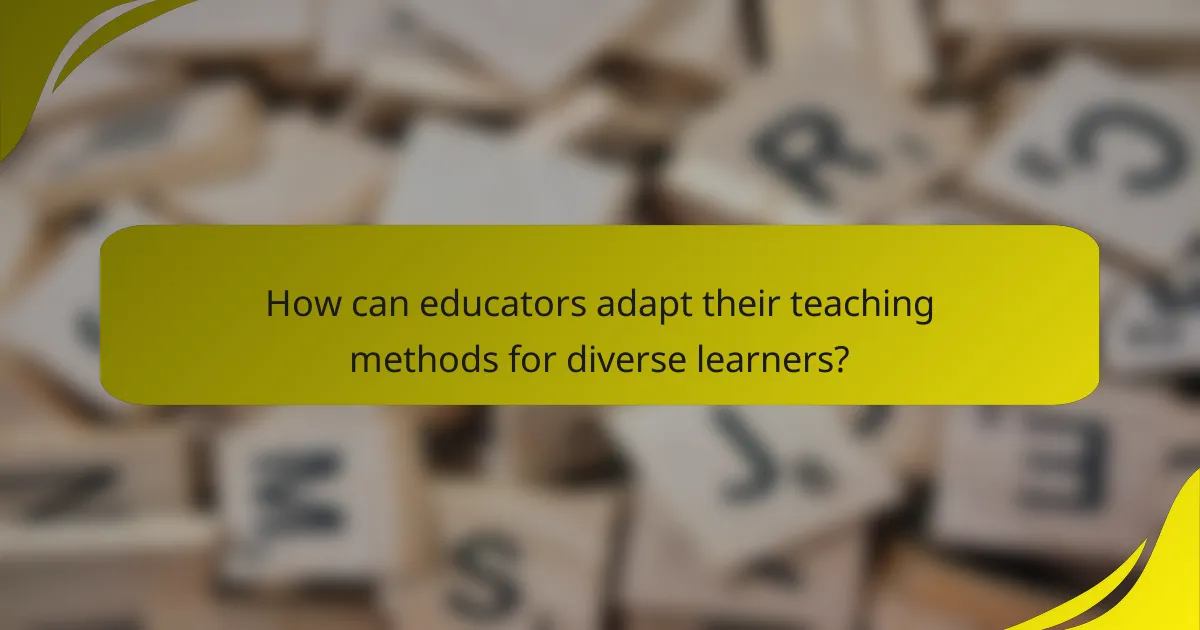
How can educators adapt their teaching methods for diverse learners?
Educators can adapt their teaching methods for diverse learners by implementing differentiated instruction. This approach tailors learning experiences to meet individual needs. For example, teachers can use varied instructional strategies such as visual aids, hands-on activities, and technology integration.
Research indicates that differentiated instruction can improve student engagement and achievement. A study by Tomlinson (2001) highlights its effectiveness in addressing diverse learning styles. Additionally, educators can assess student readiness, interests, and learning profiles to create personalized learning plans.
Collaboration with students and families also enhances understanding of diverse needs. By fostering an inclusive classroom environment, educators can support all learners effectively.
What are some practical techniques for modifying lesson plans for diverse learners?
Differentiated instruction is a practical technique for modifying lesson plans for diverse learners. This approach tailors teaching methods to meet varied student needs. Teachers can adjust content, process, and product based on individual learning profiles. For example, visual aids can support visual learners, while hands-on activities benefit kinesthetic learners. Flexible grouping allows students to collaborate in diverse teams, enhancing peer learning. Scaffolding provides support structures to help students gradually master complex concepts. Additionally, offering choices in assignments can increase engagement and motivation. Research shows that these strategies improve learning outcomes for all students, especially those with diverse educational needs.
How can visual aids and technology support diverse learners in art education?
Visual aids and technology significantly enhance art education for diverse learners. They provide multiple means of engagement and representation. Visual aids, such as images and diagrams, help clarify complex concepts. Technology, including tablets and interactive software, allows for personalized learning experiences. These tools cater to various learning styles, such as visual, auditory, and kinesthetic. Research shows that students using visual aids perform better in creative tasks. A study by Mayer (2009) indicates that multimedia learning improves comprehension and retention. Thus, integrating visual aids and technology supports diverse learners effectively in art education.
What considerations should be made for students with different learning styles?
Considerations for students with different learning styles include recognizing visual, auditory, and kinesthetic preferences. Visual learners benefit from diagrams and visual aids. Auditory learners thrive on discussions and verbal instructions. Kinesthetic learners excel through hands-on activities and movement. Incorporating a mix of teaching methods caters to these diverse needs. Assessing individual learning styles can enhance engagement and retention of information. Research indicates that tailored instruction improves academic performance in diverse classrooms. Adapting teaching strategies fosters an inclusive environment that supports all learners effectively.
What challenges do educators face when teaching diverse learners in art education?
Educators face several challenges when teaching diverse learners in art education. One significant challenge is varying cultural backgrounds. Each student brings unique perspectives that may influence their understanding of art. Another challenge is differing skill levels among students. Some learners may have more experience or talent than others, creating disparities in class participation. Language barriers also pose difficulties. Students who are not proficient in the primary language of instruction may struggle to grasp concepts. Additionally, educators must address different learning styles. Some students may benefit from visual aids, while others may prefer hands-on activities. Limited resources can further complicate teaching efforts. Many art programs lack adequate materials to support diverse learning needs. These challenges require educators to adapt their teaching strategies effectively.
How can teachers overcome barriers to effective teaching for diverse learners?
Teachers can overcome barriers to effective teaching for diverse learners by implementing differentiated instruction. This approach tailors teaching methods to meet varied student needs. Teachers should assess individual learning styles and adapt their strategies accordingly. Utilizing multiple forms of assessment helps identify specific challenges faced by learners. Collaborative learning environments encourage peer support and engagement. Incorporating culturally relevant materials enhances relatability and interest in the subject matter. Professional development opportunities equip teachers with effective strategies for inclusivity. Research indicates that differentiated instruction improves student outcomes in diverse classrooms. For instance, a study by Tomlinson (2001) highlights increased student achievement through tailored teaching practices.
What resources are available to support educators in addressing these challenges?
Resources available to support educators include professional development programs, online courses, and workshops. These resources help educators enhance their teaching strategies. Organizations like UNESCO provide guidelines and materials tailored for diverse learners. Additionally, local educational authorities offer training sessions focused on inclusive practices. Educational technology platforms also provide tools for differentiated instruction. Research studies highlight the effectiveness of these resources in improving educational outcomes. For example, a study by the International Society for Technology in Education emphasizes the role of technology in supporting diverse learning needs. These resources collectively empower educators to effectively address challenges in Palestinian art education.
What best practices can educators adopt for teaching diverse learners in Palestinian art education?
Educators can adopt several best practices for teaching diverse learners in Palestinian art education. First, they should implement culturally responsive teaching methods. This involves integrating local art forms and traditions into the curriculum. Such integration helps students connect their personal experiences with their learning.
Second, differentiation is crucial. Educators should tailor their instruction to meet the varying needs of students. This can include providing multiple ways for students to express their understanding. For instance, some may prefer visual projects, while others may excel in written reflections.
Third, fostering an inclusive environment is essential. Classrooms should encourage collaboration among students from diverse backgrounds. Group projects can promote peer learning and enhance creativity.
Lastly, continuous professional development is important for educators. Training on cultural competence can improve their ability to engage with diverse learners. Research shows that teachers who understand their students’ backgrounds can better support their academic success.
How can ongoing professional development enhance teaching strategies for diverse learners?
Ongoing professional development enhances teaching strategies for diverse learners by equipping educators with updated skills and knowledge. It allows teachers to understand the varied cultural, linguistic, and learning needs of their students. Continuous training helps educators adopt inclusive practices that cater to these differences. Research shows that teachers who engage in professional development improve their instructional techniques. For example, a study by Desimone (2009) indicates that effective professional development leads to increased student engagement and achievement. Furthermore, ongoing training fosters collaboration among educators, promoting the sharing of best practices tailored to diverse classrooms. This collaborative approach helps in developing innovative strategies that address unique challenges faced by diverse learners.
What community resources can support inclusive art education practices?
Community resources that can support inclusive art education practices include local art organizations, community centers, and educational institutions. Local art organizations often provide workshops and programs tailored for diverse learners. Community centers may host inclusive events that promote participation from all backgrounds. Educational institutions can offer specialized training for teachers in inclusive practices. Collaboration with these resources fosters an environment that values diversity in artistic expression. Studies show that inclusive art education enhances creativity and engagement among students from varied backgrounds.
Teaching Strategies for Diverse Learners in Palestinian Art Education focuses on effective instructional methods tailored to accommodate varied learning styles and cultural backgrounds. Key strategies include differentiated instruction, culturally relevant pedagogy, and collaborative learning, which enhance engagement and inclusivity. The article explores the specific needs of diverse learners, the impact of cultural context on teaching approaches, and the importance of implementing diverse strategies to improve academic outcomes. Additionally, it highlights best practices for educators, the role of ongoing professional development, and community resources that support inclusive art education.
